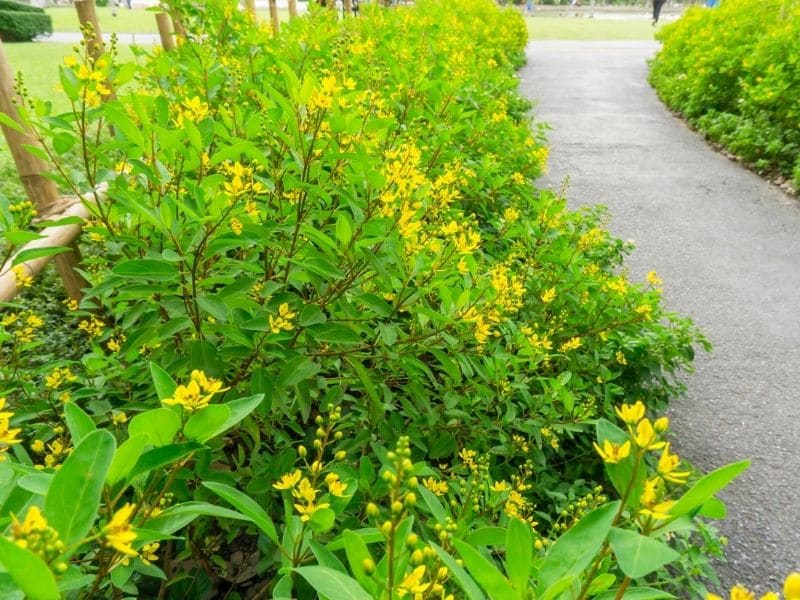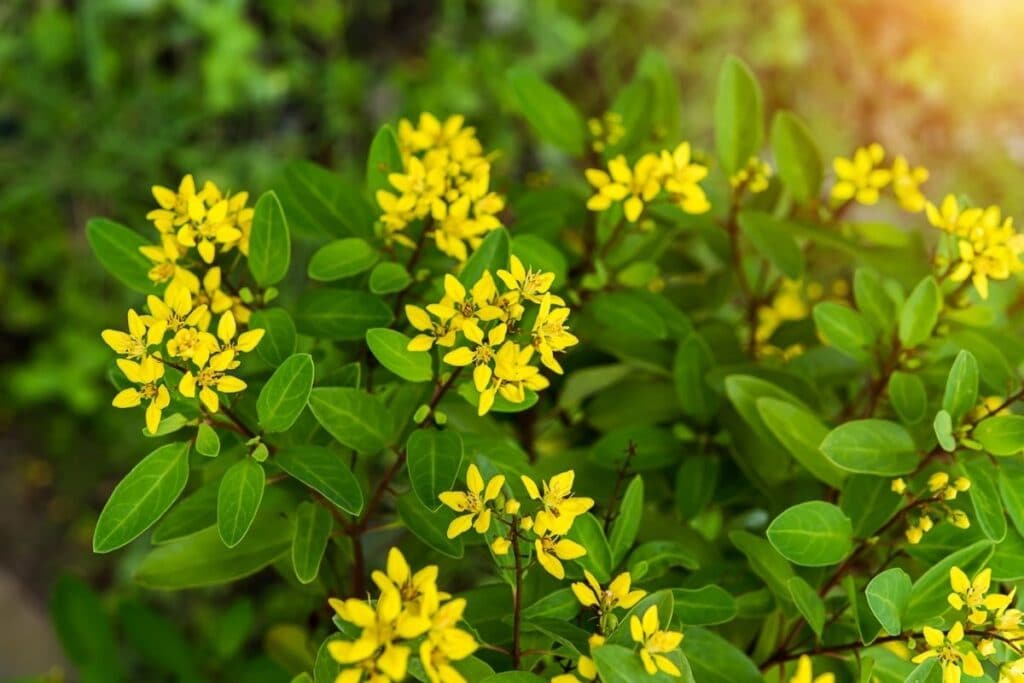Almost any garden could benefit from a showy ornamental shrub with a long flowering period, especially one with a variety of landscaping uses. If you live in a suitable climate, thryallis (Galphimia gracilis) may be a great addition to your garden.
Read on to learn more about this beautiful flowering plant.
What is a Thryallis Plant?
Thryallis, pronounced thry-al-is, is a medium-sized sun loving plant native to Mexico and Central America.
This plant goes by many common names and is also popularly known as golden thryallis, goldshower, slender goldshower, shower of gold, spray of gold, or rain of gold. It is a member of the family Malpighiaceae, a family consisting of over 1300 species that are mostly native to the tropics of Central America.
Thryallis blooms and grows best in USDA Hardiness Zones 9-11. It is considered an easy care, low maintenance plant and produces flowers year round, even late into the summer and fall and sometimes winter, in places like south Florida.
There has been some confusion regarding the correct name for this plant and technically, the thryallis commonly seen in the horticultural trade is most likely to be Galphimia gracilis, although they are often called Galphimia glauca.
The popular name thryallis itself is the outdated genus of this plant, a name which has persisted even after its correction to the current Galphimia gracilis. Understandably all this causes some confusion, so we will stick to thryallis for this article.
In the wild, this species occurs in a variety of habitats which makes it a great plant for the landscaper due to its unspecialized care requirements. It can be grown alongside horter shrubs, in mass plantings, or even against a blank wall as long as it gets enough light.
Thryallis has attractive blueish-gray green leaves and beautiful yellow flowers with reddish centers. Young stems are a lovely red-brown shade. The plants are soft and will sway gracefully in a gentle breeze.
It is naturally a perennial evergreen species, although deciduous when planted in cooler areas. This plant grows to about 6 feet tall to 9 feet tall (1.8-3m), and almost as wide, in ideal conditions but can be maintained at 3 to 4 feet (0.9-1.2m) high. Sometimes, these are considered tall trees when compared to other shrubs!

Thryallis Flowers
Heavy pruning at the start of spring will stimulate flowering in this plant in cooler climates. The rain of gold flowers are just under an inch (2cm) in diameter and have five petals and five sepals, which are bright yellow in color, and ten anthers, of varying lengths, and three styles all of a vibrant red shade.
Thryallis produces a myriad of flowers that are open simultaneously on a single inflorescence, technically described as a terminal raceme. Flowers are a cheerful bright yellow color overall with red stamens and pistil.
This plant flowers from late summer to fall in cooler climates, however, in more tropical areas the thryallis may flower year-round. The flowers are sweet-scented but not overwhelming, even when blooming en masse.
The pretty flowers of thryallis attract birds such as hummingbirds, bees, butterflies and other pollinators but thankfully, the plant is not popular with larger browsing animals like deer and rabbits.
How to Grow a Thryallis Bush
Thryallis can be grown from seed, sown in spring, or grown from cuttings, taken in summer, using a rooting hormone powder. Thryallis plants are medium to fast-growing shrubs. This plant may grow as much as 4 feet (1.2meters) in its first season and should be grown in a sunny and sheltered space.
This plant may tolerate some shade, but reduced sunshine will affect flower production and result in a thinner, more spindly-bodied plant. These plants are not very robust and do not enjoy strong winds so you may need to factor this in when selecting where to plant.
Thryallis is not an especially thirsty plant and is considered fairly drought tolerant although young and re-potted plants should be kept moist, and your plant will appreciate additional watering in very hot and dry weather. Insufficient water, as with insufficient light, may result in reduced flowering.
Over-watering is not recommended as this may result in root rot. This plant requires well drained soil.
These should be well-drained sandy soils that are mildly acidic to neutral (pH 5.6-7.5) and can be fertilized, if necessary, provided usage instructions are followed carefully. Amend the soil with organic peat humus if you need to raise the acidity for your thryallis plants.
Thryallis can be grown in areas that receive frost, however, the plants will go through a winter dormancy in such situations and die back completely to ground level after the first frost, before re-sprouting in spring. They are not considered cold hardy, but growing in mass plantings can help as it provides some winter protection even if you’re not growing in warmer areas.
Where grown in these colder climates, thryallis will not reach the same sizes as those in tropical regions due to the limited growing season and in very cold areas, it may be necessary to overwinter your potted thryallis indoors.
Care and Maintenance
Thryallis can certainly be described as a low-maintenance species. This plant may be allowed to grow freely as a showy oval-shaped shrub or be pruned or hedged. Topiary applications are even possible with this plant as it has a compact growth form and puts out new shoots only occasionally.
If you prune, you may find that it allows enough light into your plant for it to produce flowers year round, particularly if you’re already growing in full sun or live in a warm climate like that of south Florida.
Regardless of how you prune your thryallis, it is important to note that the flowers grow terminally, at the ends of branches, and therefore pruning too heavily and too often will prevent the plant from flowering to its full potential.
Pests and Diseases
Thryallis is a hardy plant that is generally not prone to attack by pests or disease. Spider mites may occasionally infest the plant but thryallis is not especially prone to attack by these common pests.
Spider mites are tiny creatures that are not easily visible to the human eye but may be identified by the pale-colored dots and fine webbing left on the undersides of leaves. These creatures may be controlled most easily with the use of a chemical miticide or an organic option such as neem oil.
Common Uses of Thryallis
Landscaping Uses
Thryallis is great for adding color and body to the garden. The pretty yellow flowers really serve to brighten up a space and will add cheer to your surroundings.
This plant prefers sunny and sheltered conditions, so it’s uses in landscaping include use as a colorful screening plant for privacy, a large-scale ground cover, a background plant for smaller focus or curiosity plants, and more. With winter protection, it can be grown as an evergreen shrub in cooler climates.
Traditional Uses
Interestingly, thryallis has a long history of use for medicinal purposes in central America. Preparations of the plant are commonly used as a homeopathic remedy for respiratory problems such as asthma and hay fever and nervous conditions like anxiety and depression.
The safety of these practices, however, has been little studied.
FAQs
*Photo by depositphotos/Noppharat_th&aimful







